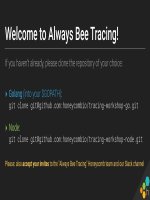IT training oreilly managing feature flags khotailieu
Bạn đang xem bản rút gọn của tài liệu. Xem và tải ngay bản đầy đủ của tài liệu tại đây (1.46 MB, 30 trang )
Co
m
pl
im
of
Adil Aijaz & Patricio Echagüe
ts
Deliver Software Faster
in Small Increments
en
Managing
Feature Flags
Managing Feature Flags
Deliver Software Faster
in Small Increments
Adil Aijaz and Patricio Echagüe
Beijing
Boston Farnham Sebastopol
Tokyo
Managing Feature Flags
by Adil Aijaz and Pato Echagüe
Copyright © 2018 O’Reilly Media, Inc. All rights reserved.
Printed in the United States of America.
Published by O’Reilly Media, Inc., 1005 Gravenstein Highway North, Sebastopol,
CA 95472.
O’Reilly books may be purchased for educational, business, or sales promotional use.
Online editions are also available for most titles ( For more
information, contact our corporate/institutional sales department: 800-998-9938
or
Editor: Brian Foster
Production Editor: Justin Billing
Copyeditor: Octal Publishing, Inc.
Proofreader: Matthew Burgoyne
November 2017:
Interior Designer: David Futato
Cover Designer: Karen Montgomery
Illustrator: Rebecca Demarest
First Edition
Revision History for the First Edition
2017-11-03:
First Release
The O’Reilly logo is a registered trademark of O’Reilly Media, Inc. Managing Feature
Flags, the cover image, and related trade dress are trademarks of O’Reilly Media, Inc.
While the publisher and the authors have used good faith efforts to ensure that the
information and instructions contained in this work are accurate, the publisher and
the authors disclaim all responsibility for errors or omissions, including without
limitation responsibility for damages resulting from the use of or reliance on this
work. Use of the information and instructions contained in this work is at your own
risk. If any code samples or other technology this work contains or describes is sub‐
ject to open source licenses or the intellectual property rights of others, it is your
responsibility to ensure that your use thereof complies with such licenses and/or
rights.
978-1-492-02856-7
[LSI]
Table of Contents
Abstract. . . . . . . . . . . . . . . . . . . . . . . . . . . . . . . . . . . . . . . . . . . . . . . . . . . . . . . v
1. Introduction. . . . . . . . . . . . . . . . . . . . . . . . . . . . . . . . . . . . . . . . . . . . . . . . 1
The Past, Present, and Future of Feature Flagging
2
2. How Are Feature Flags Commonly Used?. . . . . . . . . . . . . . . . . . . . . . . . 5
A New Carousel
Use Cases
5
9
3. Succeeding with Feature Flags. . . . . . . . . . . . . . . . . . . . . . . . . . . . . . . 11
The Moving Parts of a Flagging System
Implementation Techniques
Testing Flagged Systems
11
12
14
4. From Continuous Delivery to Continuous Experimentation. . . . . . . 17
Capabilities Your Flagging System Needs
18
5. Conclusion. . . . . . . . . . . . . . . . . . . . . . . . . . . . . . . . . . . . . . . . . . . . . . . . 21
iii
Abstract
Managing Feature Flags
For almost as long as we’ve written software programs, we’ve
included ways to control what those programs do at runtime via
configuration options or flags. Feature flags are a modern applica‐
tion of this concept, focused on accelerating software delivery. What
began in the late 2000s as a way for fast-moving software teams to
work on half-finished code without disrupting their users has
evolved into a standard practice for modern product delivery teams
who want to deliver functionality in small increments and learn
from their users.
In this book, we’ll look at the history of feature flags and, more
importantly, learn how teams can successfully apply these techni‐
ques. We’ll examine different types of feature flags and what makes
them different. We’ll see some critical code-level techniques to keep
our feature flagging code manageable, and we’ll explore how to keep
the number of flags in our code base to a manageable level.
v
CHAPTER 1
Introduction
Feature flags (aka toggles, flips, gates, or switches) are a software
delivery concept that separates feature release from code deploy‐
ment. In plain terms, it’s a way to deploy a piece of code in produc‐
tion while restricting access—through configuration—to only a
subset of users. They offer a powerful way to turn code ideas into
immediate outcomes without breaking anything in the meantime.
To illustrate, let’s assume that an online retailer is building a new
product carousel experience for customers to easily view featured
products. Here is a quick example of how it could use a flag to con‐
trol access to this feature:
if (flags.isOn("product-carousel")) {
renderProductImageCarousel();
} else {
renderClassicProductImageExperience();
}
Here flags is an instance of a class that evaluates whether a user has
access to a particular feature. The class can make this decision based
on something as simple as a file, a database-backed configuration, or
a distributed system with a UI.
1
The Past, Present, and Future of Feature
Flagging
The fundamental concept behind feature flags—choosing between
two different code paths based on some configuration—has proba‐
bly been around almost as long as software itself.
In the 1980s, techniques like #ifdef preprocessor macros were com‐
monly used as a way to configure code paths at build time. They
were primarily used for supporting compilation to different CPU
architectures, but were also commonly used as a way to enable
experimental features that would not be present in a default build of
the software in question.
Although these preprocessor techniques supported only the selec‐
tion of code paths at build time, other commands like commandline flags and environment variables have been used for decades to
support runtime feature flagging.
Continuous Delivery
Around 2010, a software development philosophy called Continu‐
ous Delivery (CD) was beginning to gain traction, centered on the
idea that a code base should always be in a state that it could be
deployed to production. Enterprise software teams were embracing
Agile methodologies and using CD concepts to support incremental
deployment into production. Companies that had been releasing
software every quarter were beginning to release every two weeks,
with huge efficiency gains as a result. Around the same time, start‐
ups like IMVU, Flickr, and later, Etsy had been taking this idea to its
logical conclusion, deploying to production multiple times a day.
To achieve these incredibly aggressive release cadences, teams were
throwing away the rulebook, abandoning concepts like long-lived
release branches and moving toward trunk-based development. Fea‐
ture flagging was a critical enabler for this transition. Teams work‐
ing on a shared branch needed a way to keep the code base in a
stable state while still making changes. They needed a way to pre‐
vent a half-finished feature going live to users in the next produc‐
tion deployment. Feature flags provided that capability, and became
a standard part of the CD toolbox.
2
| Chapter 1: Introduction
Experimentation
Around the same time as this revolution in software delivery practi‐
ces, folks like Steve Blank and Eric Ries were sparking a parallel rev‐
olution in product management. The Lean Startup methodology
brought a heavy focus on rapid iteration (powered by CD, in fact)
along with a scientific approach to product management using A/B
testing.
Software delivery teams quickly realized that they could use the
same feature flagging techniques that they had been using for release
management to power their A/B tests. Though this was a great ena‐
bler for rapid product development, it also led to some growing
pains as product managers suddenly became heavy users of homegrown feature flagging systems that had been built as an internal
tool for engineers. These growing pains continue today as the wave
of modern product management sweeps through our industry. Later
in this book, we discuss how to mitigate some of the issues that
arise.
Today, feature flagging systems are seen primarily as a tool for fea‐
ture management. This is evidenced by the fact that most modern
feature flagging systems are oriented around which users are
exposed to a given feature. Previously, the primary axis would be
around which environment or cluster of servers get a given feature.
What’s Next?
For many product delivery organizations, it has become the norm
for any change to be managed by feature flags. Product changes are
no longer “launched” or “released”—they are incrementally rolled
out. As we’ll discuss later on, this might involve an initial “cham‐
pagne brunch” rollout to internal users, followed by a canary release
to 5% of regular users, followed by an incremental ramp to 100%.
Rolling out a change involves monitoring the impact of that change.
When feature flags were mostly the domain of engineers, the met‐
rics being watched would be technical in nature—CPU load, request
latency, database transactions per second. As feature flagging has
moved into the domain of product management, the nature of these
metrics has shifted toward higher-level business key performance
indicators (KPIs)—active users, conversion rates, and business trans‐
actions per hour.
The Past, Present, and Future of Feature Flagging
|
3
Today, pioneering organizations are using that feedback loop to
automate the rollout (and rollback) of features. This will become
more mainstream as more organizations improve their ability to tie
feature releases to business metrics, closing and tightening the feed‐
back loop that powers product delivery.
4
|
Chapter 1: Introduction
CHAPTER 2
How Are Feature Flags
Commonly Used?
To understand how feature flags are used, we’ll follow along with a
hypothetical team that’s just starting with feature flags.
Our software delivery team works at Acme Corporation, a large
online retailer. This particular team is responsible for the Product
Details page, owning both the user interface for this page and the
functionality that powers it. The team has been experiencing a lot of
pain recently with branch management and merge conflicts, and has
been researching ways to reduce this pain. The tech lead believes
that feature flags could be a way to reduce the amount of branching
and merging the team needs to do. The team agrees to try this
approach for their next big piece of upcoming work.
A New Carousel
The Product Details page includes images of the product, and the
team is planning to roll out a new carousel-based user experience
for these product images. Typically, they would work on the new UI
in a feature branch, perform validation, testing and sign-off against
that branch, eventually merging the branch with their shared release
branch so that the new functionality can be deployed to production
(and into the hands of their users). Instead of that approach, the
team plans to experiment with using feature flags as a way to enable
trunk-based development.
5
They incrementally develop their new carousel experience on the
shared release branch, but add some conditional logic so that it
shows the new experience only when appropriate.
Initially, they keep the decision as to whether to show the new expe‐
rience a hardcoded constant:
function renderProductDetailsPage() {
const showNewProductImageCarousel = false;
// ... lots of rendering code...
if (showNewProductImageCarousel) {
renderProductImageCarousel();
} else {
renderClassicProductImageExperience();
}
// ... more rendering code...
}
This hardwired approach is sufficient for a short while. It allows
development of the new carousel code to proceed on a shared
branch without affecting other developers (or end users). Develop‐
ers working on the new functionality can test it out locally by flip‐
ping the hardcoded constant to true. However, this approach is not
sustainable. It’s only a matter of time before someone actually checks
in a change, which flips the constant! Aside from that, there is no
way to run automated tests against the new functionality because it
is hardwired off. It’s also not possible for a nondeveloper to test out
the carousel, for the same reason.
The team needs to allow the decision to show the carousel to be a
runtime decision.
Dynamic Decisions
The implementation evolves. Here’s what it looks like now:
function renderProductDetailsPage() {
// ... lots of rendering code...
if (flags.isOn(“product-carousel”)) {
renderProductImageCarousel();
} else {
renderClassicProductImageExperience();
}
// ... more rendering code...
}
6
|
Chapter 2: How Are Feature Flags Commonly Used?
By deciding to show the new feature as a runtime decision, encapsu‐
lated within a flags object, you can specify the state of this feature
in the context of an automated test. More generally, it allows the
user to configure the state of features outside of the code itself, and
allows for control over the decision to show the carousel or not via
configuration. The potential to show the carousel is always present,
but the code path is not always exposed. It is “dark” or “latent” code.
Release Management
Now that flagging decisions are being made via configuration, the
team has the option of making that flag configuration environment
specific. This means having the ability to turn the new carousel on
for a staging environment for testing while still not exposing it to
end users in a production environment.
When the team is confident that the new carousel is ready for prime
time, it can push a configuration change to production that turns
the feature on for users. If something goes wrong, the team can use
another simple configuration change to roll back the feature.
Canary Releases
The team has now been using feature flags in this manner for a
while. It’s comfortable with using a configuration change to roll out
a latent feature to users, but many team members aren’t satisfied that
a feature release is an all-or-nothing affair—either the feature is
exposed to no users or all users. The team wants to move to a more
sophisticated Canary Release in which a feature is initially exposed
to 5% of users and then rolled out to more and more users if it is
performing as expected.
To enable Canary Releasing, the team modifies the feature flagging
decision logic to take the current user into account when making a
toggling decision:
if (flags.isOn("our-new-feature", {user: request.user})) {
showOurNewFeature();
}
Rather than configuring a feature as Off or On, it now configures a
rollout percentage (e.g., 5%). The flagging system consistently buck‐
ets any given user into a release range from 0% to 100% and uses
that position, together with the currently configured rollout per‐
centage, to decide whether to show the current user the given
A New Carousel
|
7
feature. The team can now incrementally roll out a feature by gradu‐
ally reconfiguring the rollout percentage for the feature in produc‐
tion.
Up to this point, feature configuration has been fairly static. The
team has been incorporating the configuration into its code deploy‐
ment, which means that every feature flag configuration change has
required a redeploy. With the addition of Canary Releasing, the
team’s configuration has become a lot more dynamic, and it decides
to move feature flag configuration out to a separate system that
allows dynamic reconfiguration on the fly, without a deployment or
process restart.
Experiments
The team’s product manager notices that it now has the ability to
expose a feature to half of its user base. Wouldn’t this be adequate
for A/B testing? The team agrees that the basic capabilities are there.
What’s needed is integration with its analytics platform so that it can
correlate a user’s experimental cohort with their behavior. The team
also needs to begin thinking about how to ensure its A/B tests are
statistically valid, including making sure that a rollout percentage
doesn’t change in the middle of an experiment.
Recap
This team’s journey is a fairly typical (if somewhat compressed)
example of how an engineering organization’s usage of feature flags
can evolve and expand over time. The team initially intended to use
feature flags for a fairly narrow purpose (i.e., avoiding merge con‐
flicts). As time went on, the team became more comfortable with the
technique and saw a broader applicability.
We skipped some additional feature flag variants—operations folks
wanting to use a feature flag to turn off expensive subsystems when
under heavy traffic, and product managers wanting to expose some
features to only premium customers.
During this evolution in usage, the code where feature flagging deci‐
sions were needed—the toggle point—remained in a fairly consistent
shape: if feature X is On, execute code path A; otherwise, execute
code path B. However, the code making the flagging decision—the
toggle router—evolved quite dramatically, becoming configurable
and starting to perform cohorting and bucketing of users. Likewise,
8
|
Chapter 2: How Are Feature Flags Commonly Used?
feature flag configuration became both more complex and more
dynamic.
Use Cases
At a high level, feature flags accelerate development by powering the
following use cases:
Continuous Delivery
Central to Continuous Delivery (CD) is the idea that your prod‐
uct is always in a releasable state. Teams practicing CD also
often practice trunk-based development, in which all develop‐
ment happens on a single shared branch (i.e., trunk, master, and
head) with feature branches being short lived (i.e., going only a
few days before being merged). Trunk-based development helps
teams to move faster by integrating their changes constantly
and avoiding the “merge hell” caused by long-lived branches.
The only way to ensure that a shared branch is always releasable
is to hide unfinished features behind flags that are turned off by
default. Otherwise, CD can turn into continuous failure.
Testing in production
New feature releases are preceded by functional QA and perfor‐
mance testing. This testing requires the creation of a User
Acceptance Test (UAT) or staging environment with a sample of
production data. This sampling and copying of production data
is problematic. For starters, it’s a red flag for data privacy and
security-conscious teams. Second, these staging environments
are not a faithful replica of production infrastructure, so you
need to take any performance evaluations with a grain of salt.
Feature flags allow teams to perform functional and perfor‐
mance tests directly on production with a subset of customers.
This is a secure and performant way of understanding how a
new feature will scale with customers.
Kill a feature
By having a feature behind a flag, you can not only roll it out to
subsets of customers, but you also can remove it from all cus‐
tomers if it is causing problems to customer experience. This
idea of “killing” a feature is better than having to do an emer‐
gency fix or a code rollback.
Use Cases
|
9
Ops toggles are a generic term for the idea of having certain fea‐
tures reside permanently behind a flag that you can kill or turn
off, maintaining a minimum viable functionality of the product
under high load or exceptional circumstances
Migrating to microservices
Microservices is the practice of breaking up a huge, monolithic
release into many discrete services that you can roll out in inde‐
pendent release schedules. Like any large architectural shift, a
monolith breakup is best tackled as a series of small steps that
incrementally moves the system toward the desired state. By
taking advantage of the capabilities of a feature flagging frame‐
work, you can make this transition safe, and in a controlled
manner.
Paywalls
You can use feature flags to permanently tie features to sub‐
scription types. For instance, a feature could be available to
every customer as part of a free trial, but is gated afterward by
the customer buying a premium subscription.
10
| Chapter 2: How Are Feature Flags Commonly Used?
CHAPTER 3
Succeeding with Feature Flags
As highlighted in previous chapters, adding feature flagging capabil‐
ities to the code base can provide a broad range of benefits. How‐
ever, feature flags can also add complexity to the code base and
reduce internal quality. It’s not uncommon for teams who have
recently embraced feature flagging to feel that they have added some
tax to their software system. Code can become littered with condi‐
tional flag checks, and it can seem that every part of the code base
(and every test) has a dependency on the feature flagging infrastruc‐
ture.
In this chapter, we look at some specific techniques that you can use
to ensure that feature-flagged code is readable, maintainable, and
testable. Most of the techniques we discuss are really just good gen‐
eral software design principles applied in the context of feature flag‐
ging code. Similar to test code, feature flagging code seems to be
treated as second-class code that doesn’t need the same level of
thought as “regular” code. This is not the case, as you’ll see.
The Moving Parts of a Flagging System
Let’s define the various moving parts involved in a feature flagging
decision, based on the following example decision:
if (flags.isOn("product-images-carousel", {user: request.user})) {
renderProductImagesCarousel();
} else {
renderClassicProductImages();
}
11
Toggle Point
The toggle point is the place in the code base where you choose a
code path based on a feature flag. In this example it’s the if condi‐
tional statement in which we call flags.isOn(…).
Toggle Router
The toggle router is the code that actually decides the current state
(or “treatment”) of a given feature and provides that treatment to the
toggle point. In our example, flags is an instance of a toggle router.
Toggle Context
Toggle context is contextual information that is passed from the tog‐
gle point to the toggle router. The toggle router can use this context
when deciding what treatment to return to the toggle point. In a typ‐
ical web application, the toggle context is based on the current
request being processed. In a mobile application, the toggle context
might be based on the device running the application. In our exam‐
ple here, the toggle context consists of the user being serviced by the
current request.
Toggle Config
Toggle config is the set of rules that the toggle router uses to decide
the treatment of a given feature. For instance, the config in the pre‐
vious example might range from the simple “only for user X” to the
complex “10% of users in California.” When beginning with flag‐
ging, teams configure toggle routers via config files or database
records. As the scope extends to include product managers and the
experimentation use case, configurations increase in complexity and
often require a friendly UI for editing purposes.
Implementation Techniques
Here are some specific techniques that can be used to ensure that
feature-flagged code is readable, maintainable, and testable.
Keep Decision Point Abstracted from Decision Reason
It is important to keep the toggle config abstracted behind the toggle
router for two key reasons.
12
|
Chapter 3: Succeeding with Feature Flags
First, it makes it easier to increase the complexity in a toggle config
without affecting the rest of the code base. For instance, in the
beginning, the Acme Corporation team might want to show the
product image carousel only to employees for dogfooding the prod‐
uct. As part of the launch, the team might want to show the carousel
to only 20% of visitors from California who use a mobile device. By
abstracting the toggle config, the complexity of the configuration
can be increased without affecting the rest of the code.
Second, abstraction helps with testing the code. We cover this sub‐
ject later in this chapter, but suffice it to say that abstraction helps
with mocking the toggle router and lets us try different configura‐
tions in a preproduction environment than we would use in a pro‐
duction environment.
Avoid Multiple Layers of Flags
A common mistake teams new to feature flagging make is to add
toggle points for the same feature at all levels of the stack. They put a
feature flag in the UI layer, in the mobile application, and in the
backend code. At best, this causes confusion. At worst, it can lead to
a feature being turned on in the UI layer but off in the backend.
One way to avoid this mistake is to follow the principle of highest
common access point. In simple terms, place the toggle point in the
highest layer of the stack that is common to all user traffic. If a fea‐
ture is accessible both on the web and in the mobile application, the
highest common point for traffic from these two clients is the back‐
end, which is the ideal location for placing this toggle point. On the
other hand, if the feature is available only in the UI, place the toggle
point in the UI.
This approach avoids duplication of toggle points and the pitfalls
that come with it.
Retire Features
Although feature flags reduce the pain of integrating long-lived
branches and the resulting bugs due to bad merges, they come with
their own set of challenges. Instead of a large number of feature
branches, a feature-flagged code base has a large number of toggle
points. The conditional logic of these toggle points is a form of code
smell; the longer it stays in the code, the more difficult it becomes to
test or debug that code.
Implementation Techniques
|
13
A best practice to avoid these problems is to have a process around
retiring and removing feature flags from code. Processes are best
enforced via code, not meetings, so it is best to automate the process
of tallying the age of feature flags and opening tickets against engi‐
neering owners to clean up the flags.
Testing Flagged Systems
Feature flags throw a wrench into traditional QA techniques. Tradi‐
tionally, there is one release branch to be certified. The branch
might have a number of features added to an existing product which
are available to all customers the moment the release is deployed.
However, there is only one version of the product to test.
In a feature-flagged world, each one of the new features may be “on”
or “off,” depending on the customer. Instead of a single product to
test, there are hundreds or thousands of versions of the product
depending on the combination of features that are turned on or off
for the customer. It is an unreasonable expectation for the QA team
to certify all possible combinations of features before the release.
Test Individual Features, Not Combinations
Testing the combinatorial explosion of multiple feature flags sounds
good in theory, but in practice, it is neither good engineering nor
needed. Instead, it is best to test each feature in isolation for all
states of the feature (e.g., on and off).
This is because most features do not interact with another. The
product carousel is likely independent of the new preferences tab
that is being rolled out. It is this assumption of independence that
makes it possible for you to test features in isolation.
However, when you cannot assume independence, you should test
all possible combinations. As an example, let’s look at two features:
one controlling a new home page design, and another controlling
the product carousel redesigned for the new home page. These two
features are not independent. In fact, the toggle config for the latter
can take into account the state of the former. In this scenario, the
QA team should test all possible combinations of the two features.
14
|
Chapter 3: Succeeding with Feature Flags
How to Automate Testing?
Automation is central to the Agile philosophy. The abstraction of a
toggle router is key to making it easier to automate testing for
feature-flagged code.
From a unit-testing perspective, you can mock the toggle router to
generate the state of the features to be tested.
When looking at regression tests, a toggle router can be backed by a
configuration file that hardcodes the state of every feature for a spe‐
cific series of regression tests. To run the entire suite, you can run
tests with the router initialized with the appropriate configuration
file.
Testing Flagged Systems
|
15
CHAPTER 4
From Continuous Delivery to
Continuous Experimentation
In the introduction of this book, we touched upon the convergence
of continuous delivery (CD) and experimentation driving “lean
product development,” with feature flags being the foundational ele‐
ment powering this convergence.
Let’s explore the trends and practices that are driving this conver‐
gence.
CD became a well-defined strategy among forward-thinking engi‐
neering teams, and stemmed from the need for businesses to rapidly
iterate on ideas. At the same time, product management teams were
adopting lean product development concepts, such as customer
feedback loops and A/B testing. They were motivated by a simple
problem: up to 90% of the ideas they took to market failed to make a
difference to the business. Given this glaring statistic, the only way
to be an effective product management organization was to iterate
fast and to let customer feedback inform investment decisions in
ideas.
Common elements began to emerge, connecting both these trends
in day-to-day software development and delivery. These elements
included the need for rapid iteration, safe rollouts through gradual
exposure of features, and telemetry to measure the impact of these
features on customer experience. The resulting outcome is that
modern product development teams are beginning to treat CD and
experimentation (i.e., a more generic term for A/B testing) as two
17









